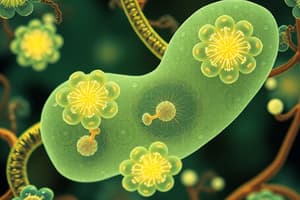Podcast
Questions and Answers
What is the primary mechanism by which insulin lowers blood glucose levels?
What is the primary mechanism by which insulin lowers blood glucose levels?
- Promoting glucose uptake by cells and inhibiting hepatic glucose production (correct)
- Inhibiting glucose uptake by cells
- Increasing glucagon secretion from the pancreas
- Stimulating the breakdown of glycogen in the liver
Which of the following best describes the role of glucagon in blood sugar regulation?
Which of the following best describes the role of glucagon in blood sugar regulation?
- Promotes glycogenolysis and gluconeogenesis in the liver, increasing blood glucose (correct)
- Stimulates glucose uptake by muscle cells
- Inhibits glycogenolysis and gluconeogenesis in the liver
- Decreases fatty acid synthesis in adipose tissue
In glucose metabolism, what is the primary fate of pyruvate under anaerobic conditions, such as during intense exercise?
In glucose metabolism, what is the primary fate of pyruvate under anaerobic conditions, such as during intense exercise?
- Breakdown into carbon dioxide and water
- Storage as glycogen in the liver
- Conversion to acetyl-CoA for the citric acid cycle
- Conversion to lactate (correct)
Which cells in the endocrine pancreas are responsible for secreting insulin?
Which cells in the endocrine pancreas are responsible for secreting insulin?
What is a key characteristic of type 2 diabetes?
What is a key characteristic of type 2 diabetes?
How does glucagon influence lipid metabolism?
How does glucagon influence lipid metabolism?
Which hormone inhibits both insulin and glucagon secretion?
Which hormone inhibits both insulin and glucagon secretion?
What is the process by which the liver synthesizes glucose from non-carbohydrate sources called?
What is the process by which the liver synthesizes glucose from non-carbohydrate sources called?
Which hormone would be released in response to a decrease in blood glucose levels after skipping a meal?
Which hormone would be released in response to a decrease in blood glucose levels after skipping a meal?
What is the primary role of insulin in adipose tissue?
What is the primary role of insulin in adipose tissue?
A patient with type 1 diabetes forgets to take their insulin injection. Which metabolic state is most likely to occur?
A patient with type 1 diabetes forgets to take their insulin injection. Which metabolic state is most likely to occur?
Which of the following is a direct effect of insulin on the liver?
Which of the following is a direct effect of insulin on the liver?
What is the role of pancreatic polypeptide (PP) cells?
What is the role of pancreatic polypeptide (PP) cells?
In a healthy individual, what would be the immediate response to a large carbohydrate-rich meal?
In a healthy individual, what would be the immediate response to a large carbohydrate-rich meal?
Which of the following is a common long-term complication of poorly managed diabetes mellitus?
Which of the following is a common long-term complication of poorly managed diabetes mellitus?
During intense exercise, what metabolic process is favored to provide energy?
During intense exercise, what metabolic process is favored to provide energy?
What is the typical fasting blood glucose range in a healthy individual?
What is the typical fasting blood glucose range in a healthy individual?
Which of the following is a lifestyle modification commonly recommended for managing diabetes?
Which of the following is a lifestyle modification commonly recommended for managing diabetes?
What is the primary target organ of glucagon?
What is the primary target organ of glucagon?
What is the underlying cause of type 1 diabetes?
What is the underlying cause of type 1 diabetes?
Flashcards
Insulin Function
Insulin Function
Hormone from pancreas that lowers blood glucose by enabling glucose uptake into cells and storage as glycogen.
Pancreatic Response
Pancreatic Response
The pancreas releases insulin when blood glucose is high, and glucagon when blood glucose is low.
Glucagon Function
Glucagon Function
Hormone that stimulates the liver to break down glycogen into glucose and release it into the bloodstream.
Glycolysis
Glycolysis
Signup and view all the flashcards
Glycogenesis
Glycogenesis
Signup and view all the flashcards
Glycogenolysis
Glycogenolysis
Signup and view all the flashcards
Gluconeogenesis
Gluconeogenesis
Signup and view all the flashcards
Beta Cells
Beta Cells
Signup and view all the flashcards
Alpha Cells
Alpha Cells
Signup and view all the flashcards
Somatostatin Function
Somatostatin Function
Signup and view all the flashcards
Glucagon
Glucagon
Signup and view all the flashcards
Lipolysis
Lipolysis
Signup and view all the flashcards
Glucagon's Primary Target
Glucagon's Primary Target
Signup and view all the flashcards
Glucagon Inhibition
Glucagon Inhibition
Signup and view all the flashcards
Glucagon Medication
Glucagon Medication
Signup and view all the flashcards
Study Notes
- Blood glucose concentration control is vital for overall health, influencing energy levels and organ function.
- The human body maintains blood glucose within a narrow range, typically 70-100 mg/dL (3.9-5.6 mmol/L) when fasting.
- Deviations from this range (hyperglycemia or hypoglycemia) can indicate metabolic disorders or other health issues.
Insulin Function
- Insulin, a hormone produced by the pancreas, plays a key role in regulating blood glucose levels.
- After a meal, when blood glucose rises, insulin is released into the bloodstream.
- Insulin enables glucose uptake by cells, particularly in the liver, muscles, and adipose tissue.
- In the liver and muscles, glucose is stored as glycogen, a complex carbohydrate.
- In adipose tissue, glucose is converted into triglycerides (fats) for long-term energy storage.
- Insulin inhibits the liver's production of glucose (gluconeogenesis), further lowering blood glucose.
- By promoting glucose uptake and storage, insulin lowers blood glucose levels back to the normal range.
Blood Sugar Regulation Mechanisms
- Blood sugar regulation involves a complex interplay of hormones, organs, and feedback loops.
- The pancreas is the primary organ responsible for sensing and responding to changes in blood glucose.
- When blood glucose is high, pancreatic beta cells secrete insulin.
- When blood glucose is low, pancreatic alpha cells secrete glucagon.
- Glucagon stimulates the liver to break down glycogen into glucose (glycogenolysis) and release it into the bloodstream.
- Glucagon also promotes gluconeogenesis in the liver, synthesizing glucose from non-carbohydrate sources.
- The balance between insulin and glucagon ensures that blood glucose remains within a narrow, healthy range.
- Other hormones, such as cortisol, epinephrine (adrenaline), and growth hormone, can also influence blood glucose levels, generally increasing them during stress or fasting.
Glucose Metabolism
- Glucose metabolism encompasses all the biochemical processes involving glucose in the body.
- After absorption from the digestive tract, glucose is transported to cells throughout the body.
- Inside cells, glucose is broken down through glycolysis, producing ATP (energy), pyruvate, and NADH.
- Pyruvate can then enter the mitochondria for further oxidation via the citric acid cycle, generating more ATP.
- Alternatively, pyruvate can be converted to lactate under anaerobic conditions (e.g., during intense exercise).
- Glucose can also be used for glycogen synthesis (glycogenesis) in the liver and muscles, or for fatty acid synthesis in the liver and adipose tissue.
- The liver plays a central role in glucose metabolism, acting as a glucose buffer by storing and releasing glucose as needed.
Diabetes Management
- Diabetes mellitus is a chronic metabolic disorder characterized by elevated blood glucose levels.
- Type 1 diabetes results from the autoimmune destruction of pancreatic beta cells, leading to insulin deficiency.
- Type 2 diabetes is characterized by insulin resistance (reduced responsiveness of cells to insulin) and relative insulin deficiency.
- Effective diabetes management involves lifestyle modifications, medication, and regular monitoring of blood glucose.
- Lifestyle modifications include dietary changes (e.g., limiting carbohydrate intake, increasing fiber intake), regular physical activity, and weight management.
- Medications for diabetes include insulin injections or pumps (for type 1 and some cases of type 2 diabetes), and oral medications that improve insulin sensitivity, stimulate insulin secretion, or reduce glucose absorption.
- Regular blood glucose monitoring (using a glucose meter or continuous glucose monitor) helps individuals with diabetes manage their blood glucose levels and adjust their treatment plan as needed.
- Careful management of blood glucose can help prevent or delay the long-term complications of diabetes, such as cardiovascular disease, kidney disease, nerve damage, and eye damage.
Endocrine Pancreas Cells
- The endocrine pancreas contains specialized cells called islet cells, which produce and secrete hormones that regulate blood glucose.
- Beta cells are the most abundant type of islet cell, producing and secreting insulin in response to high blood glucose.
- Alpha cells produce and secrete glucagon in response to low blood glucose.
- Delta cells produce somatostatin, which inhibits the release of both insulin and glucagon.
- PP cells produce pancreatic polypeptide, which plays a role in appetite regulation and gastric emptying.
- The coordinated action of these islet cells ensures precise control of blood glucose levels.
Glucagon
- Glucagon is a peptide hormone secreted by alpha cells of the pancreatic islets in response to low blood glucose levels.
- It is a key counter-regulatory hormone to insulin, working to raise blood glucose when it falls too low.
- Glucagon primarily targets the liver, stimulating glycogenolysis (breakdown of glycogen into glucose) and gluconeogenesis (synthesis of glucose from non-carbohydrate sources).
- By promoting glucose release from the liver, glucagon increases blood glucose levels.
- Glucagon secretion is inhibited by high blood glucose levels, insulin, and somatostatin.
- In addition to its effects on glucose metabolism, glucagon can also influence lipid metabolism, promoting lipolysis (breakdown of stored fats) in adipose tissue.
- Glucagon is used as a medication to treat severe hypoglycemia (very low blood glucose) in individuals with diabetes.
Studying That Suits You
Use AI to generate personalized quizzes and flashcards to suit your learning preferences.




